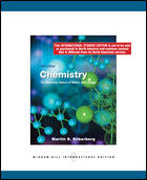
Classware for General Chemistry. · This e-homework program will feature algorithmically-generated questions, rich feedback and adapted learning modules. · New molecular art! New pieces of the spectacular molecular art that has been asignature of previous editions are included. · These drawings enable studentsto gain a better understanding of the three-dimensionality of molecules and the details of chemical reactions. · New and revised end-of-chapter problems! Many completely new problems relate to daily life and to practical aspects of chemistry. Silberberg offers three types of problems: Concept Review Questions test students' general understanding of key ideas in the chapter. Skill-Building Exercises are written in pairs, with one of each pair answered in the back of the book. These exercises begin simply and increase gradually in difficulty. Problems in Context apply the skills learned to interesting scenarios and examples. These three types of problems, which are keyed by chapter section, arefollowed by a group of Comprehensive Problems that are presented in any order, include problems from every section, and often call on concepts and skills learned in earlier chapters. · Reinforcement of concepts, skills, and problem-solving strategies presented in each chapter is vital to the student achieving success. Presenting a variety of problems with a varying degree of background information will teach students to think critically by implementing the Plan, Solve, Check, and Practice strategy rather than relying on rote memorization. · Thinking Logically to Solve Problems. A four-step problem-solving approach is used to facilitate student reasoning, not memorizing, toward a solution. Plan. After a problem is stated, the steps are verbally planned to show how to move from what is known to what is unknown. Solve. Next, the plan is executed bynaming each calculation step and then carrying out the math. Check. The next step is to check that the answer makes sense both chemically and mathematically. Sometimes a Comment appears about common pitfalls and alternative approaches. Practice. A follow-up problem that requires the same concept to solve it appears immediately after the sample problem, and a brief, worked-out solution is provided at the end of the chapter. · This approach promotes learning, not memorizing chemistry, and models a predictable and flexible pattern of reasoning rather than just plugging numbers into an equation. Follow-up problems allowthe student to engage in active learning of the problem-solving paradigm. If students can develop a sound approach to thinking through an idea and solving problems they will do well in the course. · 3-Level Depictions of Chemical Events. Ground-breaking art program that consistently combines photographs of chemical events with a coordinated molecular view of that event and with the equation that symbolically and quantitatively describes that event. · Enhances a simultaneous understanding of chemical reality, concepts, and symbolism. Instantly translates chemical events and processes into a form understandable by people of all learning styles. · Chemical Connections. Interdisciplinary science boxes appear throughout the book to show how chemistry is related to other sciences. Nearly all biochemical topics occur within this feature as do essays onspecific topics in geology, industrial technology, environmental issues, and so forth. · Addresses career interests while applying a concept to a real world situation. Many examples pertain to life science and engineering applications. · Tools of the Laboratory. Laboratory boxes that describe some of the instruments commonly used in chemical research. The principle behind the measuring instrument pertains directly to the topic at hand in the text. · Benefit: Students learn the background of experiments, procedures, and other tactical issues confronted in the lab all within the context of the chapter being discussed.· Galleries. Single or multi-page illustrated summaries of concepts and applications. For example, Chapter 11 has a full-page gallery that applies the properties of liquids to everyday events. New to 3e, the gallery on batteries (Chapter 21) now includes the nickel-metal hydride type and the latest informationon H2-based fuel cells, all based on expert input. · Focuses on the application of a single chemical concept to everyday experience. Enhances student motivation and understanding of that concept.
- ISBN: 978-0-07-128354-0
- Editorial: McGraw-Hill
- Encuadernacion: Rústica
- Páginas: 1100
- Fecha Publicación: 01/02/2008
- Nº Volúmenes: 1
- Idioma: Inglés
